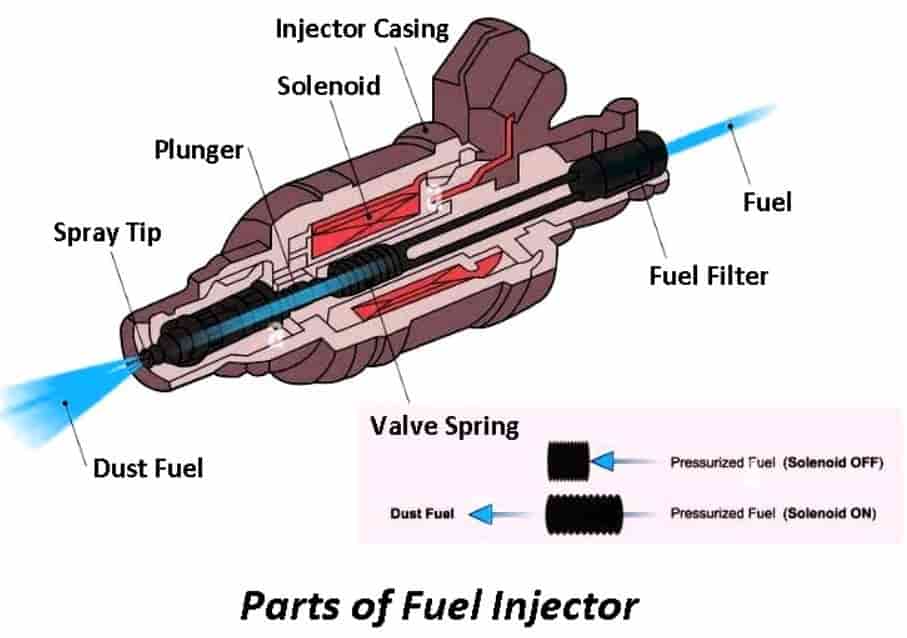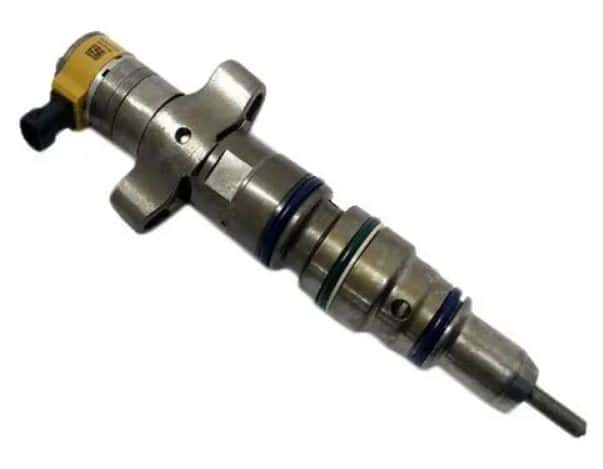In this article, you’ll learn What is a Fuel Injector. Its diagram, parts, working, types, and Symptoms all are explained with pictures.
Also, you can download the PDF file at the end of this article.
What is a Fuel Injector?
In automotive engines, fuel is introduced through injectors into the combustion chamber; this is called fuel injection. Fuel injectors are mechanical devices used to inject/spray fuel into engines to produce the correct air-fuel mixture, leading to efficient combustion.
In 1920, Bosch created the first diesel fuel injector in response to rising fuel demand and prices. Introducing fuel injection to vehicles improved acceleration and fuel efficiency, making engines more powerful and fuel efficient.
Modern types of injectors may also measure the amount of fuel injected as directed and controlled by the ECM (Electronic Control Module). Gasoline fuel injectors work like carburetors, where air and fuel are drawn in by a vacuum created when the piston descends.
The injector position varies for different engine configurations, but they are usually mounted on the engine head with a tip inside the combustion chamber. In diesel engines, it is mounted in the engine head inside the combustion chamber, while in petrol engines, it is mounted in the intake manifold.
Read Also: Different Types of Spark Plugs Used in Vehicles?
Parts of Fuel Injector
The following are the main parts of the injector:
- Injector body
- Plunger
- Valve spring
- Nozzle
- Fuel filter
- Electromagnets
- Electronic plug or connection

#1 Injector Body
Also known as the shell, this is the outer surface of the fuel injector. Inside the fuel injector, all other parts of the injector are arranged like a garden shower.
The injector’s inner surface is designed to have a capillary or passageway through which high-pressure fuel from the fuel pump can flow for further spray.
#2 Plunger
A plunger is used at the narrow end of an injector to open or close a nozzle under the action of fuel pressure operated by the fuel distributor or engine governor.
In an electronically controlled fuel injector, the opening of the nozzle is controlled electronically with the help of electromagnets.
#3 Valve Spring
Two springs are used in mechanically controlled fuel injectors.
- Plunger Spring: The forward and backward motion of the plunger is controlled by a plunger spring which operates when fuel pressure inside the fuel injector increases. Due to this action, it opens and closes the nozzle and returns to its initial position when the pressure is reduced.
- Main Spring: Its job is to control the inlet of the fuel injectors. It operates under the action of fuel pressure provided by the fuel pump.
#4 Nozzle
Fuel injector nozzles interact with the pistons in the combustion chambers. Its job is to spray a mixture of fuel and air into the combustion chamber. The nozzle hole design aims to ensure a sufficient fuel flow for maximum torque and power under the available injection pressure.
#5 Fuel Filter
The fuel filter is a part of the injection system, as today’s fuel injectors are close-fitting parts. A fuel filter is usually found on the fuel line to filter out contaminants such as dirt, dust, debris, and rust particles from the fuel. It protects vital engine parts by filtering out foreign particles that potentially damage fuel injectors.
#6 Electromagnets
Unlike mechanically controlled fuel injectors, this type of injector is equipped with electromagnets around the plunger. It receives an electronic signal from the engine’s electronic control unit to open the nozzles through an electronic plug or a connection to the fuel injectors.
#7 Electronic Plug or Connection
A connection or plug is located on the bottom of an electronically controlled fuel injector. With this plug, an electronic signal from the ECU is transferred to an electromagnet, which opens a nozzle to spray fuel.
Read Also: What is an Electronic Ignition System? Diagram, Working and Uses
Working of Fuel Injector
An injector may be mechanically controlled or electrically controlled. Let us understand the working of both the fuel injectors below.

#1 Mechanically Controlled Fuel Injector
As the engine starts, the fuel pump pumps fuel to the fuel distributor, which starts regulating the timing and amount of fuel to be sprayed. Fuel is transferred to the fuel injectors as directed by the fuel distributor through the fuel lines.
Upon reaching the injector, this highly pressurized fuel pushes the inlet or main spring into the injector due to its high pressure. As this fuel enters the fuel injector, it starts pushing the plunger spring, which in turn pushes the plunger outwards, opening the nozzle and resulting in fuel spraying.
Fuel injection is accomplished for a particular cycle as per the inputs provided by the fuel distributor. Injector pressure drops, causing the plunger spring to maintain its initial position. The nozzle closes, and the fuel spray stops.
#2 Electronically controlled Fuel Injector
As soon as the engine starts, the fuel pump works in conjunction with the engine’s electronic control unit. An electronic control unit controls the timing, amount, and pressure of fuel entering the fuel injectors via the fuel pump.
ECU sends a signal to the injector with the help of an electronic connection. These electronic signals from the ECU actuate the electromagnets inside the fuel injectors, this pushes the plunger outwards, which opens the nozzle, and finally, the fuel is sprayed.
When the particular cycle is completed, the electronic signal from the ECU is turned off, which deactivates the electromagnets. Due to this, the plunger returns to its initial position, as a result of which the nozzle is closed, and fuel injection stops.
Read Also: Different Types of Fuel Gauge and Their Uses
Types of Fuel Injectors
There are various fuel injection arrangements, such as throttle body fuel injection, multi-point fuel injection, sequential fuel injection, and direct fuel injection, that have been developed as a result of advancements in fuel injection technologies.
They can be used according to the application, but when it comes to fuel injector types, they are hard to categorize. According to general use, fuel injectors can be classified as follows.
- Based on fuel
- Diesel fuel injector
- Petrol fuel injector
- Based on fuel metering
- Mechanically controlled fuel injector
- Electronically controlled fuel injector
Based on Fuel
There are two types of fuel injectors, which can be classified based on the type of fuel they are intended to inject.
#1 Diesel Fuel Injector
Diesel fuel injectors are used in diesel engines to inject or spray diesel (usually heavier than gasoline) directly into the engine’s combustion chamber for further combustion. It delivers precise amounts of atomized and pressurized fuel to each cylinder.
Highly atomized, pressurized fuel is evenly distributed throughout the cylinder by the injector, which leads to power and fuel economy, reduced engine noise, and smooth operation. Diesel fuel injectors have a capillary and nozzle that can form diesel packets that spray fuel into the combustion chamber.
#2 Petrol or Gasoline Fuel Injector
As the name suggests, gasoline fuel injectors are those that are used to spray gasoline either directly into the combustion chamber of the engine or through an intake manifold to initiate the subsequent combustion with a spark plug.
The capillary and nozzle of the gasoline fuel injector are usually smaller or similar to those of diesel fuel injectors, depending on the requirement. Since gasoline is lighter than diesel, gasoline injectors do not require as much injection pumping as diesel injectors.
Based on Fuel Metering
Fuel injectors are classified into two types according to the way they measure fuel (and thus control the speed, quantity, and pressure of the fuel), namely:
#3 Mechanical Controlled Fuel Injectors
As the name implies, these types of fuel injectors mechanically control the speed, amount, timing, and pressure of fuel with the help of a spring and plunger. The mechanically controlled fuel injector takes input from the cam and fuel pump system or fuel distributor (in the modern type).
#4 Electronically Controlled Fuel Injectors
These types of fuel injectors electronically control the speed, amount, pressure, and timing of the fuel with the help of an electronic solenoid. An electronically controlled fuel injector receives input from the fuel distributor or the vehicle’s electronic control unit (in modern type).
Read Also: What is Timing Belt? Working, Symptoms and Replacement
Symptoms of Fuel Injectors
The following are the symptoms of fuel injectors:
- Your engine may misfire if you have a clogged or dirty fuel injector.
- A dirty fuel injector can cause an unstable fuel supply, resulting in engine over-revving.
- When the fuel injector won’t shut off or starts to leak, you may experience reduced fuel economy.
- You may notice a strong gasoline smell if the injector won’t shut off or leaks.
- If you notice an uneven engine while idling, the problem could be a dirty fuel injector.
Wrapping It Up
I believe that fuel injectors are an outstanding technology that has had a fundamental impact on many ignition problems across the globe that were previously difficult to solve. As a result, it will create a more powerful engine that emits less pollution and has an eco-friendly design.
I hope I have covered everything in this article. If I missed something, or if you have any doubts, let me know in the comments. If you liked this article, please share it with your friends.
Want free PDFs direct to your inbox? Then subscribe to our newsletter.
Download PDF of this article:
You might like to read more in our blog:
- How does a Rotary Engine work? Parts & Functions
- What is an Ignition Distributor? Its Parts, Working, Problems
- Working of Cylinder Block: Parts, Types, & Applications [PDF]
FAQs
A fuel injector controls the injection of fuel into an engine’s internal combustion chamber, where it reacts with air and ignites. The combustion chamber converts the chemical energy in diesel, hydrogen, and natural gas into power for the vehicle.
Depending on the vehicle type, fuel injector brand, and repair location, replacing a fuel injector might cost anywhere from $300 to $900.
They are still prone to problems, though. Fuel contamination is the most frequent cause of early failure, while numerous other factors can also lead to breakdowns. Fuel contamination happens when dirt in the fuel escapes the filtration and destroys the sealing surfaces.
Cleaning fuel injectors at home necessitates the use of a fuel injector cleaner kit and simple tools such as a wrench. The injectors need to be taken out of the fuel rail system, cleaned with the recommended injector cleaner solution, and then put back into the engine.
That was pretty good. And I want to learn more
Thanks for your feedback. You can explore our website. We have written more than 100 articles.
Am also studying Mechanical Engineering and am in my second year.I would like to get in attach with you
Great to hear from a fellow Mechanical Engineering student! Be sure to subscribe to our newsletter to stay connected with us.